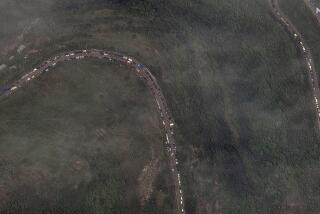Exploring the Places Where ‘Altitude Shapes Attitude’
- Share via
Born in Israel, Washington-based journalist Yo’av Karny felt he had a special sympathy for small nations struggling to survive. This is what motivated him to visit the Caucasus, that fabled, mountainous region between the Black and Caspian seas containing some 30-odd “nations,” or ethnic groups, whose roots stretch back across the centuries. During the last decade, this region has been much in the news as one group, the Chechens, has battled for independence from Russia, while farther south, old wounds fester in the conflict between Armenia and Azerbaijan.
In a purportedly post-ideological world, where so many people seem to lack convictions, let alone the courage to defend them, there is something poignant, even stirring, about people willing to die for their freedom. As Karny notes, this passion is often found among people who live at high altitudes, from the Swiss hero William Tell and Scottish highlanders to the Hmongs of Southeast Asia. In 1994, in fact, highlanders from Asia, Africa, Europe and South America met in the Caucasian city of Nalchik for a conference based on the idea that “altitude shapes attitude”--in other words, that “perceptions need not be dictated by hereditary factors or cultural predisposition but could be affected by . . . the thinness of the air one breathes, or the height of trees, or their absence . . . a wonderful antidote,” Karny feels, “to the accentuated tribalism and hyped-up nationalism of the day.”
But as Karny also observed during the course of his travels, as chronicled in “Highlanders,” mountaineers have long, and not always accurate, memories: “Retaining the forgettable and avenging the forgivable are still defining characteristics of some highlanders.” Although “anyone steeped in history would admire the long memory of the highlanders,” Karny writes, “those interested in progress and civility would frown. . . . The great French historian Ernest Renan had a point when he opined, ‘It is good for everyone to know how to forget.’ ”
Although highlanders’ memories go back for centuries, the former Soviet Union also sowed some of the seeds of future strife by attempting grand feats of social engineering. As Karny explains, both Czarist Russia and the Soviet Union wished to incorporate rather than subjugate ethnic minorities, and the Soviets even liked to think that they were “liberating” them. (This would have been news to the Chechens, rounded up, loaded into cattle cars and deported to Central Asia in the 1940s; or to the Balkars, who endured a similar fate.) Nonetheless, the Soviets could point to the “autonomous republics” they established, not to mention the “ethnic classification” that they “forced on every individual.” Though Western critics may have laughed at this as a mere charade, Karny believes that by “offering the nationalities their own institutions--parliaments, ministries, locally run police force . . . the [Soviet] system provided its future demolishers with precious launching pads.”
Religion is another vital element in this region inhabited by Christians, Jews and Muslims. Here again, Karny found things “much murkier and more multilayered than I had previously assumed.” In Armenia, he meets the Subbotniks, a tiny sect descended from Russian Christian peasants who chose to worship a Hebrew God and keep the Jewish Sabbath. In Chechnya, Ingushetia and Daghestan, he encounters many versions of Islam, some legalistic, some mystical, some severely ascetic, some tolerant, some peaceful, some militant.
One seemingly intelligent Islamic leader tells him that not only are Jews the root of all evil, but there also is no such thing as Christianity: It’s merely Judaism in disguise. In contrast to this ill-informed individual, Karny has taken great pains to understand and clearly delineate the beliefs of all the different sects--and individuals--he encounters.
Much as Karny cherishes the marvelous diversity of the cultures he visits, and much as he sympathizes with people who are laboring constructively to preserve their heritages, he fears the devastating potential of internecine warfare. Written with great verve and considerable scrupulousness, “Highlanders” not only sheds light on a relatively obscure area of the globe, but also conveys how very difficult it can sometimes be for even the most well-disposed outsider to tell the “good guys” from the “bad guys.”
More to Read
Sign up for The Wild
We’ll help you find the best places to hike, bike and run, as well as the perfect silent spots for meditation and yoga.
You may occasionally receive promotional content from the Los Angeles Times.






